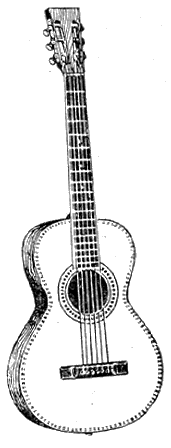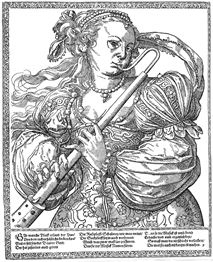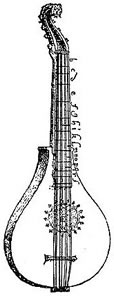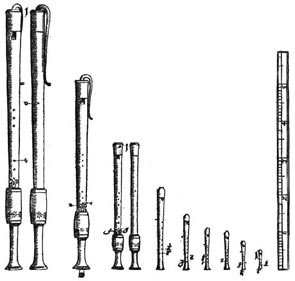Gregorian Chant
| Gregorian chant is also known as plainchant or plainsong, and is
a form of monophonic, unaccompanied singing, which was developed
in the Catholic church, mainly during the period 800-1000. It takes
its name from Pope St. Gregory the Great.
This music was traditionally sung by monks or other male clerics,
and was used during religious services. It is the music of the
Roman Rite of the Mass, also known as the Gregorian rite or Tridentine
rite. Other rites of the mass, such as the Assyrian or Coptic use
different melodies but share the unaccompanied and monophonic nature
of the Gregorian, which allude to a common source. |
|
Guitars
 A guitar is a stringed musical instrument played with the
fingers or a plectrum (guitar pick). A guitar is a stringed musical instrument played with the
fingers or a plectrum (guitar pick).
Instruments like the guitar have been popular for at least 5,000 years;
murals in Egypt show women playing instruments like the guitar from the
time of the Pharaohs, but the name "guitar" appears first in
Spain in the 13th century. It was probably a deriviation of the Arabic
word qitara, the name of an instrument that was brought into Spain by
the Moors after the 10th Century.
The Spanish vihuela appears to be an intermediate form, with lute-style
tuning and a small guitar-style body, but it is not clear whether this
represents a transitional form or simply a design that combined features
from the two families of instruments.
Guitars have frets on the fingerboard, to fix the positions of the notes,
or scale which gives them equal temperament. Guitars usually have six
strings, although there are variations on this, the most common being
a twelve-string guitar, the seven string guitar, the ukulele, which has
four strings, and the bass guitar, which usually has four strings but
also exists in five, six and twelve-string versions. The vihuela was a
guitar variation with six double strings made of gut, which emerged in
16th century Spain.
A variety of different tunings are used. The most common by far, known
as "standard tuning", is (low to high) E-A-d-g-b-e'. Standard
tuning has evolved to provide a good compromise of both simple fingering
for many chords, and the ability to play common scales with minimal left
hand movement.
The Shawm
The shawm was a Renaissance musical instrument of the woodwind family, made in Europe from the late 13th century until the 17th century. It was ancestral to the modern oboe.It had a long bore which started straight but widened into a conical end, and had a double reed. It produced a loud shrill tone, and was used by military bands during the Crusades, as well as in ordinary life for dancing.
The oboe developed from the shawm in the mid-17th century when the French musicians Jean Hotteterre and Michel Danican Philidor modified it, producing an instrument with a narrower bore and a reed which is held by the player's lips near the end.
|  |
The Cittern
 The cittern is a stringed instrument dating from the Renaissance, having evolved considerably since that time. It is similar to several other instruments, notably the bouzouki, with which it is often confused. The cittern is a stringed instrument dating from the Renaissance, having evolved considerably since that time. It is similar to several other instruments, notably the bouzouki, with which it is often confused.
The Renaissance cittern was one of the few metal-strung plectrum-plucked instruments from the period. Generally four courses (pairs) of strings, the cittern uses a range of only a major 6th between its lowest and highest strings, and employs a "re-entrant" tuning. The tuning and narrow range allow the player a number of simple chord shapes useful for both simple song accompaniment and dances, and its bright and cheerful timbre make it a valuable counterpoint to gut-strung instruments. Other variations on the cittern are the bandore (or bandora), a bass instrument. Likewise the Spanish bandurria, is similar, but also having some characterstics of the more standard lute.
Modern citterns, bouzoukis (zouks), octave mandolins, mandolas, mandocellos, and mandolins are members of a family of instruments distinguished by being strung in 2 string courses with metal strings, usually in unisons but sometimes in octaves, made of wood, usually with a floating bridge/ tailpiece arrangement, and usually tuned in 5ths or open tunings. The body shape is usually teardrop based, rather than the waisted design of a guitar or violin.
A cittern has come to mean usually a 10-string instrument of this family with a short scale length, ie below 22". The modern use of the term "cittern" is attributed to British luthier Stefan Sobell who devised a pear-shaped, 8-string instrument influenced by designs of English and Portuguese guitars with their flat backs, ovoid bodies, and double-course strings. After seeing pictures of Rennaisance citterns and noting the resemblance to his new design, he chose the name "cittern" to describe his instruments.
The Recorder
 The recorder is a flute-like woodwind musical instrument. Contrariwise, the flute is a recorder-like woodwind musical instrument. In German it is called the Blockflöte, in French the flûte à bec, and in Italian the flauto dolce. It is held vertically from the lips (rather than horizontally like the 'transverse' flute). The player's breath is directed by a wooden 'fipple' or 'block' in the mouthpiece of the instrument along a duct called the 'windway', hence its membership in the family of "fipple flutes", which also includes such instruments as the tin whistle. Exiting from the windway, the breath is directed against a hard edge called the labium, which agitates a column of air, the length of which (and the pitch of the note produced) is modified by finger holes in the front and back of the instrument. Because of the fixed position of the windway with respect to the labium, there is no need to form an embouchure with the lips. On the other hand the shape and size of the recorder player's mouth cavity has a discernable effect on the timbre, tone and response of the recorder -- but we could hardly call this an "embouchure". This is similar to the functioning of the ancestors of the recorder, early folk whistles. The recorder is a flute-like woodwind musical instrument. Contrariwise, the flute is a recorder-like woodwind musical instrument. In German it is called the Blockflöte, in French the flûte à bec, and in Italian the flauto dolce. It is held vertically from the lips (rather than horizontally like the 'transverse' flute). The player's breath is directed by a wooden 'fipple' or 'block' in the mouthpiece of the instrument along a duct called the 'windway', hence its membership in the family of "fipple flutes", which also includes such instruments as the tin whistle. Exiting from the windway, the breath is directed against a hard edge called the labium, which agitates a column of air, the length of which (and the pitch of the note produced) is modified by finger holes in the front and back of the instrument. Because of the fixed position of the windway with respect to the labium, there is no need to form an embouchure with the lips. On the other hand the shape and size of the recorder player's mouth cavity has a discernable effect on the timbre, tone and response of the recorder -- but we could hardly call this an "embouchure". This is similar to the functioning of the ancestors of the recorder, early folk whistles.
Recorders are most often tuned in C and F, though instruments in D, G, Eb were not uncommon historically and are still found today especially the Tenor in D known as a voice flute. The normal, school instrument, recorder is the soprano in C (in Britain also known as the descant) which has a lowest note of c'. Above this are the sopranino in F and the gar klein Flötlein ("really small flute") in C, with a lowest note of c". An experimental 'piccolino' has also been produced in f". Below the soprano are the alto in F (in Britain also known as the treble), tenor in C and basset in F (in Britain known as the bass) . Lower instruments in C and F exist (bass in C - in Britain also known as the Great Bass, contrabass in F, subcontrabass in C, and sub-subcontrabass or octo-contrabass in F) but are more rare. They are also difficult to handle: the contrabass in F is about 2 meters tall. The soprano and the alto are the most common solo instruments in the recorder family.
The range of a recorder is about 2 octaves, chromatically. The instrument can be played chromatically over two octaves and a fifth by a skilled player, except for the augmented prime, two octaves and one semitone above the base note. This note is either absent or can only be played by covering the end of the instrument, typically by using one's upper leg or a special bell key. Basically, a recorder is a diatonic instrument, with one hole for each note of the scale of its lowest note, although the upper half of the second octave requires irregular fingerings. Two versions exist, one using the major scale and an older one using the lydian scale.
>> Learn about Composers of the Middle Ages
|
|
Related Links:
The Middle Ages
The Black Plague
The Violin
|

